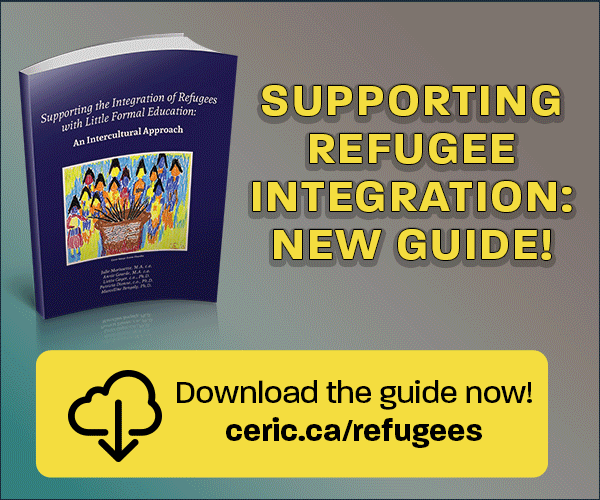Successful Career Decision-Making of Young Canadians in a Digital Economy
DOI:
https://doi.org/10.53379/cjcd.2024.400Keywords:
Digitization, digital economy, COVID-19, career development, career counselling, young people, enhanced critical incident techniqueAbstract
Young Canadians are making career decisions in a labour market context that is being transformed by technology and digitization. The rapid, unbalanced shifts brought on by technology and automation have left gaps in knowledge related to how young people are navigating their career decisions considering the emergence of the digital economy and the way career practitioners can best support young people in successfully exploring career options. This study explored factors that helped and hindered 14 young adults who self-identified as doing well navigating career decision-making within the multiple options, opportunities, and challenges posed by the digital economy.
References
Anderson, M. L., Goodman, J., & Schlossberg, N. K. (2012). Counseling adults in transition: Linking Schlossberg’s theory with practice in a diverse world. New York, NY: Springer.
Arnett, J. J. (2000). Emerging adulthood: A theory of development from the late teens through the twenties. American Psychologist, 55(5), 469–480.
Arntz, M., Gregory, T., & Zierahn, U. (2016). The risk of automation for jobs in OECD countries: A comparative analysis. OECD Social, Employment and Migration Working Papers. No. 189, OECD Publishing, Paris. https://doi.org/10.1787/5jlz9h56dvq7-en
Arthur, N., & Collins, S. (Eds.). (2010). Culture-infused counselling. Calgary, AB, Canada: Counselling Concepts.
Arthur, N., & Flynn, S. (2011). Career development influences of international students who pursue permanent immigration to Canada. International Journal for Educational and Vocational Guidance, 11(3), 221-237.
Balsmeier, B., & Woerter, M. (2019). Is this time different? How digitalization influences job creation and destruction. Research policy, 48(8), 103765.
Beaujot, R., & Kerr, D. (2007). Emerging youth transition patterns in Canada: Opportunities and risks. Ottawa, ON: Policy Research Initiative, Government of Canada. https://ir.lib.uwo.ca/pscpapers/vol21/iss5/1/
Blustein, D. L., Phillips, S. D., Jobin-Davis, K., Finkelberg, S. L., & Roarke, A. E. (1997). A theory-building investigation of the school-to-work transition. The Counseling Psychologist, 25(3), 364-402. https://doi.org/10.1177/0011000097253002
Borgen, W. A., & Hiebert, B. (2006). Career guidance and counselling for youth: What adolescents and young adults are telling us. International Journal for the Advancement of Counselling, 28(4), 389-400. https://psycnet.apa.org/doi/10.1007/s10447-006-9022-5
Britten, L., & Borgen, W.A. (2010). Footprints of colour along the career journey. Procedia Social and Behavioural Sciences, 5, 104-115.
Butterfield, L. D., Borgen, W. A., Amundson, N. E., & Maglio, A. S. T. (2005). Fifty years of the critical incident technique: 1954-2004 and beyond. Qualitative Research, 5(4), 475-497.
Butterfield, L. D., Borgen, W. A., Maglio, A. S. T., & Amundson, N. E. (2009). Using the enhanced critical incident technique in counselling psychology research. Canadian Journal of Counselling and Psychotherapy/Revue Canadienne de Counseling et de Psychothérapie, 43(4), 265-282.
Calderon Gomez, D. (2021). The third digital divide and Bourdieu: Bidirectional conversion of economic, cultural, and social capital to (and from) digital capital among young people in Madrid. New Media & Society, 23(9), 2534-2553.
CERIC. (2023, Oct). 10 Major Changes Impacting the Futures of Work and Workers in Canada. https://ceric.ca/publications/career-development-in-2040/
Cheshmehzangi, A. (2021). From transitions to transformation: a brief review of the potential impacts of COVID-19 on boosting digitization, digitalization, and systems thinking in the built environment. Journal of Building Construction and Planning Research, 9(01), 26.
Cranford, C. J., Vosko, L. F., & Zukewich, N. (2003). The gender of precarious employment in Canada. Industrial Relations, 58(3), 454-479.
De Stefano, V. (2016). The rise of the “just-in-time workforce”: On-demand work, crowdwork and labour protection in the “gig-economy”. Conditions of Work and Employment Series, No. 71. Geneva, Switzerland: International Labour Office.
Deloitte & HRPA (2017) The intelligence revolution: Future-proofing Canada’s workforce. Deloitte. https://www2.deloitte.com/content/dam/Deloitte/ca/Documents/human-capital/ca-en-hc-IntelligenceRev-POV-Oct25-AODA.pdf
D’Silva, G., Jani, M., Jadhav, V., Bhoir, A., Amin, P. (2020). Career Counselling Chatbot Using Cognitive Science and Artificial Intelligence. In: Vasudevan, H., Michalas, A., Shekokar, N., Narvekar, M. (eds) Advanced Computing Technologies and Applications. Algorithms for Intelligent Systems. Springer, Singapore. https://doi.org/10.1007/978-981-15-3242-9_1
Eynon, R. and Geniets, A. (2016). The digital skills paradox: how do digitally excluded youth develop skills to use the internet? Learning, Media and Technology 41: 463–479.
Flanagan, J. C. (1954). The critical incident technique. Psychological Bulletin, 51(4), 327-358.
Ford, M. (2015). Rise of the robots: Technology and the threat of a jobless future. New York, NY: Basic Books.
Guichard, J. (2005). Lifelong self-construction. International Journal for Educational and Vocational Guidance, 5, 111–124.
Hirschi, A. (2018). The fourth industrial revolution: Issues and implications for career research and practice. The Career Development Quarterly, 66(3), 192-204.
Hirschi, M., Hunter, A. L., Neely-Barnes, S. L., Malone, C. C., Meiman, J., & Delavega, E. (2022). COVID-19 and the rapid expansion of telehealth in social and behavioral health services. Advances in Social Work, 22(1), 91-109
Huang K-T, Robinson L and Cotten SR (2015) Mind the emotional gap: the impact of emotional costs on students learning outcomes. In: Robinson L, Cotten SR, Schulz J, et al. (eds) Communication and Information Technologies Annual: Digital Distinctions and Inequalities, vol. 10. Bingley: Emerald Group, pp. 121–144.
Inkson, K., & Elkin, G. (2008). Landscape with travellers: The context of careers in developed nations. In J. Athanasou & R. van Esbroeck (Eds.), International Handbook of Career Guidance (pp. 69-96). Dordrecth, The Netherlands: Springer Science & Media.
Krumboltz, J. D. (2009). The happenstance learning theory. Journal of Career Assessment, 17, 135–154. https://doi.org/10.1177/1069072708328861
Lent, R. W. (2018). Future of work in the digital world: Preparing for instability and opportunity. The Career Development Quarterly, 66(3), 205-219.
Lent, R. W., Brown, S. D., & Hackett, G. (2002). Social cognitive career theory. In D. Brown & Assoc. (Eds.), Career choice and development (pp. 255-311). San Francisco: Jossey-Bass.
Leong, F. T. L., & Gupta, A. (2008). Theories in cross-cultural contexts. In J. Athanasou & R. van Esbroeck (Eds.), International handbook of career guidance (pp. 227-245). Dordrecth, The Netherlands: Springer Science & Media.
Livingstone, D. W. (2018). The education-jobs gap: Underemployment or economic democracy. Routledge.
Loranger, A., Sinclair, A., & Tebrake, J. (2018). Measuring the cconomy in an Increasingly digitalized world: Are statistics up to the task? Centre for International Governance Innovation. https://www.cigionline.org/articles/measuring-economy-increasingly-digitalized-world
Mathew, D. (2019). Career decision-making of immigrant young people who are doing well: Helping and hindering factors (Unpublished doctoral dissertation). The University of British Columbia.
McMahon, M. (2005). Career counseling: Applying the systems theory framework of career development. Journal of Employment Counseling, 42(1), 29-38.
Medici, G., Grote, G., Igic, I., & Hirschi, A. (2023). Technological self-efficacy and occupational mobility intentions in the face of technological advancement: A moderated mediation model. European Journal of Work and Organizational Psychology, 32(4), 538–548. https://doi.org/10.1080/1359432X.2023.2197215
Medici, G., Igic, I., Grote, G., & Hirschi, A. (2023). Facing change with stability: The dynamics of occupational career trajectories. Journal of Career Development, 50(4), 883-900.
Patton, W. (2008). Recent developments in career theories: The influences of constructivism and convergence. In J. Athanasou & R. van Esbroeck (Eds.), International handbook of career guidance (pp. 133-156). Dordrecth, The Netherlands: Springer Science & Media.
Policy Horizons Canada (2018). The Next Generation of Emerging Global Challenges. Horizons. https://horizons.gc.ca/en/2018/10/19/the-next-generation-of-emerging-global-challenges/#working-in-the-digital-economy
Pope, M. (2009). Career counseling with diverse adults. In J. G. Ponterotto, J. M. Casas, L. A. Suzuki, & C. Alexander (Eds.), Handbook of multicultural counseling (pp. 731–743). Thousand Oaks, CA: Sage.
Pryor, R. G. L., & Bright, J.E.H. (2011). The chaos theory of careers. New York, NY: Routledge.
Ragnedda, .M (2017). The Third Digital Divide: A Weberian Approach to Digital Inequalities. Routledge.
Riverin-Simard, D. (2000). Career development in a changing context of the second part of working life. In A. Collin & R.A. Young (Eds.), The future of career (pp. 115- 129). Cambridge, UK: Cambridge University Press.
Rosales, A., Fernández-Ardèvol, M., & Svensson, J. (2023). Digital Ageism: How it operates and approaches to tackling it. Taylor & Francis.
Savickas, M. L., Nota, L., Rossier, J., Dauwalder, J. P., Duarte, M. E., Guichard, J., Soresi, S., Esbroeck, R., & van Vianen, A. E. M. (2009). Life designing: A paradigm for career construction in the 21st century. Journal of Vocational Behavior, 75, 239-250. https://doi.org/10.1016/j.jvb.2009.04.004
Schlossberg, N. K. (2011). The challenge of change: The transition model and its applications. Journal of Employment Counseling, 48(4), 159-162. https://doi.org/10.1002/j.2161-1920.2011.tb01102.x
Schwab, K. (2017). The fourth industrial revolution. New York: NY. Crown Business.
Schwartz, S. J., Zamboanga, B. L., Meca, A., & Ritchie, R. A. (2012). Identity around the world: An overview. New Directions for Child and Adolescent Development, 138, 1-18.
Statistics Canada. (2019). Measuring digital economic activities in Canada (Catalogue no.13-605-X). https://www150.statcan.gc.ca/n1/daily-quotidien/190503/dq190503a-eng.htm
Super, D. E. (1980). A life-span, life-space approach to career development. Journal of vocational behavior, 16(3), 282-298.
Tims, M., & Bakker, A. B. (2010). Job crafting: Towards a new model of individual job redesign. SA Journal of Industrial Psychology, 36(2), 12-20.
Van Deursen A and Van Dijk J (2015) Toward a multifaceted model of Internet access for under- standing digital divides: an empirical investigation. The Information Society, 31(5): 379–391.
Warschauer, M. (2003). Demystifying the digital divide. Scientific American, 289(2), 42-47.
Woolsey, L. K. (1986). The critical incident technique: An innovative qualitative method of research. Canadian Journal of Counselling, 20(4), 242-254.

Published
How to Cite
Issue
Section
License
Copyright (c) 2024 Canadian Journal of Career Development

This work is licensed under a Creative Commons Attribution-NonCommercial-NoDerivatives 4.0 International License.
















